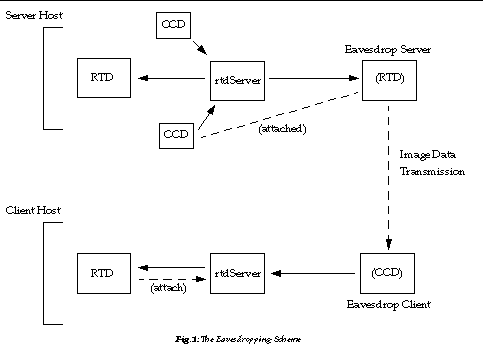We describe here the overall scheme that was used to implement the eavesdrop functionality. In this discussion, the multicast server will be known as the "eavesdrop server", to distinguish this from the local server daemon (rtdServer).
In order to retain decoupling between processes which send and receive image data, the following scheme for the multicasting ("remote eavesdropping") has been adopted. The eavesdrop server process exists as an entirely separate process to any RTD which happens to be running, but acts as an effective RTD by connecting to the server daemon and receiving images from any active CCD in the usual manner. In the absence of any eavesdrop clients, the server will then simply discard all images that it receives (taking care to service any semaphore included in the image information structure so that the CCD software does not lock up).
When an eavesdrop client is started, the user may connect to the eavesdrop server through a server browse scheme. On connection, the eavesdrop server will take the next image event from the local server and send this to the client (having first processed the data according to the options set on the eavesdrop server panel). The client will read the data into its own local buffer before sending the image information to its own local server daemon. Thus the client acts as an effective CCD for all RTDs that are local to the client machine. This situation is illustrated in the figure below. Note that many clients may connect to a single eavesdrop server.




Please send questions or comments to abrighto@eso.org.
Copyright © 1998 ESO - European Southern Observatory